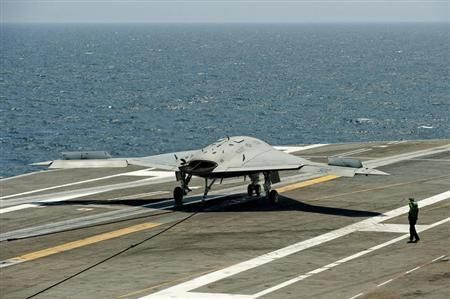First Drone Lands On Aircraft Carrier: 'Salty Dog' Pushes Limits Of Unmanned Aircraft [VIDEO]

In a significant feat of remote maneuvering, an unmanned drone has for the first time successfully landed on an aircraft carrier. The manuever is considered one of the most difficult operations, navigating both the air and a moving ship remotely, and many have said it’s a major milestone in the development of drone warfare.
The Navy's Salty Dog 502 flew from the Patuxent River Naval Station in Maryland to the USS George H.W. Bush operating off the Virginia coast, according to Reuters. Unlike other drones, Salty Dog is piloted entirely by computer with no human operator. Navy Secretary Ray Mabus described the event as "witnessing the future" and compared it to the first manned aircraft landing on a carrier in 1911.
The Salty Dog is one of two X-47B aircraft built by Northrop Grumman to experiment with incorporating drones onto aircraft carriers. It has a 2,000-mile range and can carry two guided bombs, though it is primarly designed for around-the-clock surveillance. The Salty Dog cost $1.4 billion.
The two X-47B drones probably won’t see any combat. After completing a minimum of three landings on a carrier in the next week, they will be retired to flight museums in Florida and Maryland.
Instead, the Navy’s UCLASS program will design and build drones for aircraft carriers over the next three to six years. These drones will be used for both reconnaissance and strike missions. According to Reuters, they could be valuable as a counter to missiles in China and Iran designed to limit the range of the U.S. Navy.
Others doubt whether the Navy really needs drones on carriers, saying it’s unclear how they would be more effective than land-based drones.
© Copyright IBTimes 2025. All rights reserved.





















